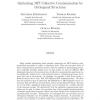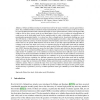396 search results - page 50 / 80 » How scientific models can explain |
VL
2009
IEEE
14 years 2 months ago
2009
IEEE
Repositories of code written by end-user programmers are beginning to emerge, but when a piece of code is new or nobody has yet reused it, then current repositories provide users ...
BMCBI
2008
13 years 7 months ago
2008
Background: Computational biology is often associated with genetic or genomic studies only. However, thanks to the increase of computational resources, computational models are ap...
CLUSTER
2006
IEEE
13 years 7 months ago
2006
IEEE
Many parallel applications from scientific computing use MPI collective communication operations to collect or distribute data. Since the execution times of these communication op...
FSE
2011
Springer
12 years 11 months ago
2011
Springer
Abstract. Bellare and Kohno introduced a formal framework for the study of related-key attacks against blockciphers. They established sufficient conditions (output-unpredictabilit...
BMCBI
2010
13 years 7 months ago
2010
Background: Genomic data provide a wealth of new information for phylogenetic analysis. Yet making use of this data requires phylogenetic methods that can efficiently analyze extr...



